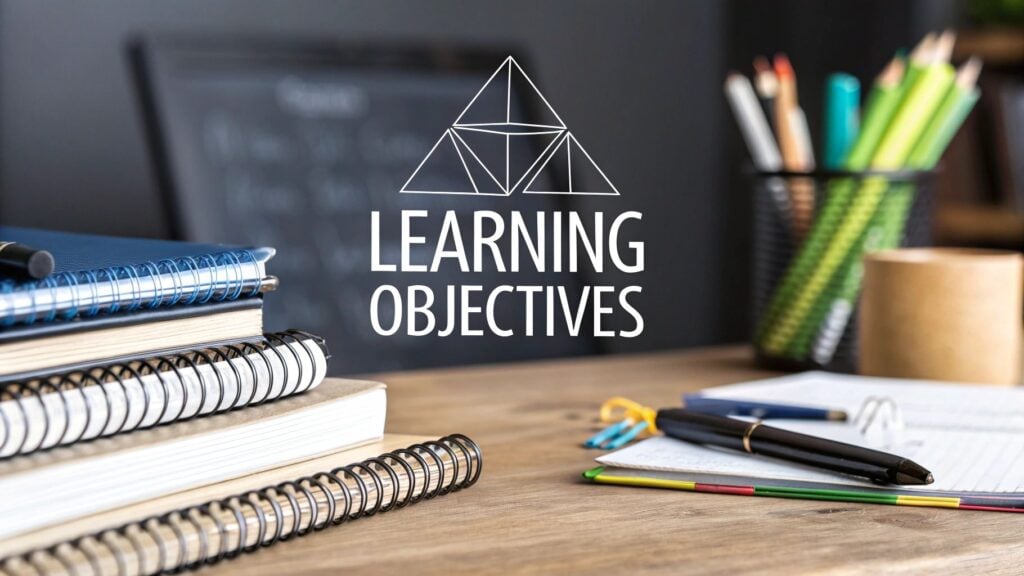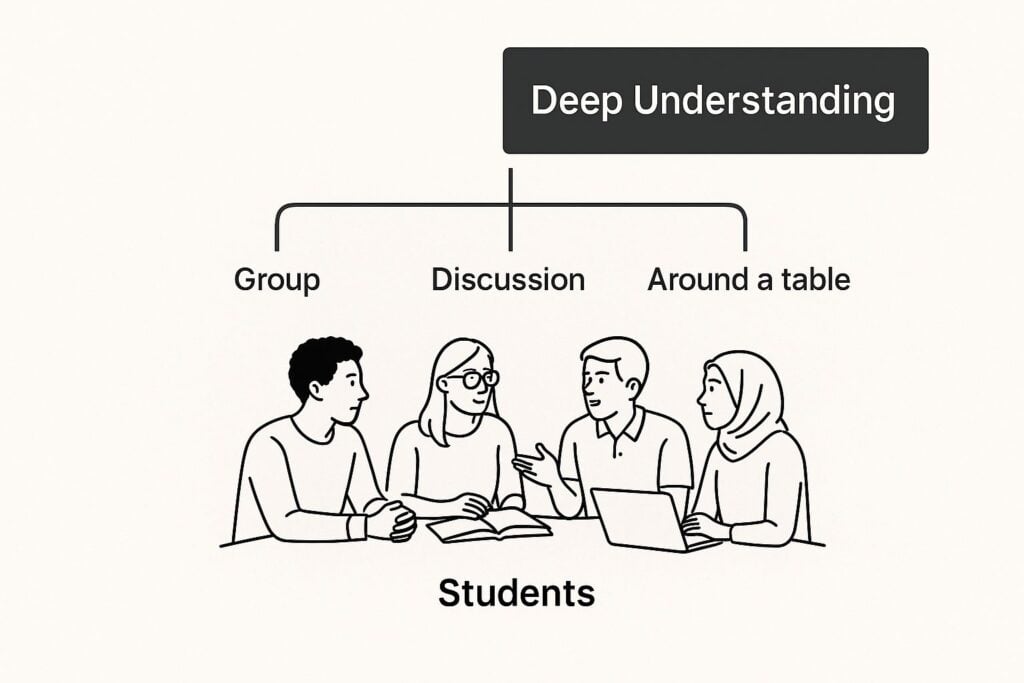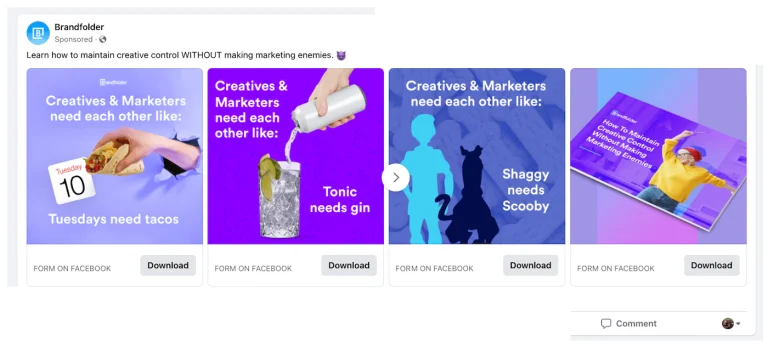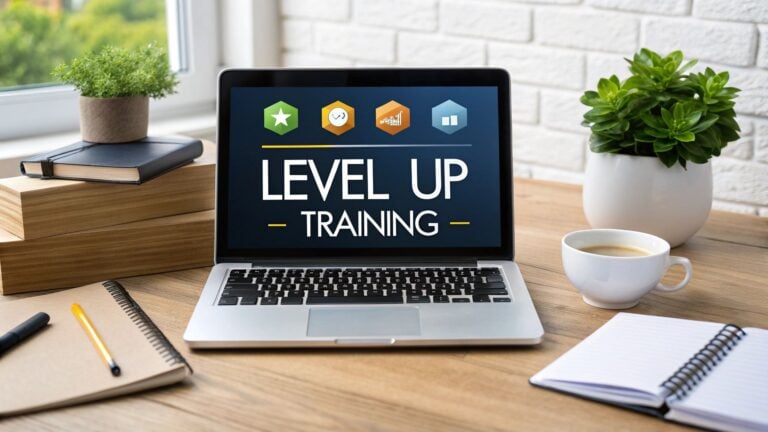Bloom’s Taxonomy Learning Objectives Made Simple

Writing effective Bloom’s Taxonomy learning objectives is the secret to getting students from just memorizing facts to actually thinking on their feet. I like to think of it as a ladder. You can’t ask someone to jump to the top rung, you have to guide them up one step at a time. This framework gives you the blueprint for that journey, helping you build lessons that create deep, lasting understanding.
What Is Bloom’s Taxonomy and Why It Matters
If you’ve ever written a lesson plan with a goal like “students will understand the topic,” you know the frustration that follows. How do you actually measure “understanding”? It feels like trying to nail Jell-O to a wall.
This is exactly the problem Bloom’s Taxonomy solves. Imagine it as a pyramid of thinking skills, designed to give educators a clear, shared language for what we want students to be able to do.
It’s a structured way to think about thinking itself.
Instead of just tossing information out there and hoping students “get it,” you can design a clear path for them. The framework helps you build lessons and tests that challenge learners in the right way at the right time. It’s all about being intentional so that real learning can happen.
A Quick History of the Framework
This idea isn’t some new trend. It’s been the bedrock of solid instructional design for decades. It was first published way back in 1956 by educational psychologist Benjamin Bloom and his team. They wanted to create a clear system for classifying the different levels of thinking that are important for learning.
The original framework has been tweaked over the years, most importantly in 2001. The big change was shifting from static nouns to action-oriented verbs like Remembering and Creating. This might seem like a small detail, but it was a huge philosophical shift. It emphasizes that learning is an active process, something students do, not just something they have.
Its six-level model has since shaped how millions of students are taught in over 50 countries. You can explore the taxonomy’s global impact on Simply Psychology to see just how far-reaching it has become.
Why Is This Still a Game Changer Today?
Decades later, this simple pyramid is still one of the most powerful tools for anyone designing a learning experience. It forces us as educators to look past surface-level teaching and start building real, durable skills in our students.
Here’s why it works so well:
- It creates clarity: When you use specific action verbs for each level, there’s no room for confusion. Everyone, including you, your students, and your colleagues, knows exactly what’s expected.
- It encourages higher-order thinking: It’s a roadmap that shows you how to guide learners beyond basic recall and toward much more valuable skills like analyzing, evaluating, and creating.
- It aligns instruction and assessment: It makes sure your tests, projects, and classroom activities are actually measuring the skills you set out to teach. No more disconnects between your lesson and your final exam.
By structuring your lessons with this pyramid in mind, you’re building a solid foundation for critical thinking, problem-solving, and genuine skill development that students can carry with them long after the lesson ends.
Climbing the Six Levels of Cognitive Learning
Think of learning like climbing a mountain. You can’t just teleport to the summit. You have to establish a base camp, acclimatize, and work your way up one stage at a time. Bloom’s Taxonomy provides that map for the ascent of the mind.
Each level represents a more complex way of thinking, and mastering the skills at one level prepares you for the challenges of the next. Let’s walk up this mountain together, starting from the very bottom.
H3: The Foundational Levels: Remembering and Understanding
The journey begins at base camp with Remembering. This is the most fundamental level, focused purely on recalling facts. It’s about being able to pull a piece of information from your memory, like naming the capitals of all 50 states or listing the ingredients in a recipe. You’re not doing anything with the information yet, you’re just proving you have it.
Once you can remember the facts, the next step is Understanding. This is where you start to make sense of them. You’re not just listing ingredients, you’re explaining why baking soda is used instead of baking powder. You’re connecting the dots and grasping the “how” and “why” behind the facts.
This is where the real learning begins to take shape.

As the image shows, moving up the hierarchy is what allows for true comprehension and the ability to collaborate and solve complex problems. It’s a journey from passive reception to active engagement.
H3: The Action-Oriented Middle Levels: Applying and Analyzing
Next up is Applying. This is where the rubber meets the road. You take the information you remember and understand, and you actually use it to solve a problem in a new situation. Following the recipe you’ve learned, you bake the cake. This is the first truly “hands-on” level of thinking.
After you can apply knowledge, you move to Analyzing. Here, you start to deconstruct information to see how all the pieces fit together. It’s like being a detective, examining clues to understand the bigger picture. You’re not just baking the cake, you’re tasting it and figuring out why it’s too dense, breaking down the relationship between the ingredients, measurements, and baking time.
H3: Reaching the Peak With Higher-Order Thinking
The final two levels are where true mastery and innovation happen. Evaluating is all about making judgments and defending your position. You might argue which of two different cake recipes is superior, using specific criteria like taste, texture, and ease of preparation to back up your claims. This requires a deep grasp of all the previous levels.
Finally, at the very summit, we have Creating. This is the pinnacle of cognitive skill. You’re no longer just following or critiquing recipes, you’re inventing your own. You combine your knowledge of ingredients, techniques, and flavor profiles to generate something entirely new.
The real power of this framework is in intentionally designing learning experiences that guide students up the entire staircase, from simple recall to innovative creation.
And this isn’t just a nice theory, it gets real results. A study in a biology course found that when instructors designed exam questions across all six levels, students’ critical thinking skills improved significantly. So many traditional courses get stuck at the bottom of the mountain, testing only recall and basic understanding. Balancing your objectives across the entire taxonomy is what leads to deeper, more durable learning. You can read more about these educational findings on the UIC’s website.
Bloom’s Taxonomy Levels and Action Verbs
So, how do you actually write objectives for each of these levels? It all comes down to choosing the right action verb. The verb is the engine of your learning objective. It tells the learner exactly what they are expected to do.
Here is a quick reference table to help you pick the perfect verb for the cognitive skill you’re targeting.
| Cognitive Level | What It Means | Example Action Verbs |
|---|---|---|
| Remembering | Recalling facts and basic concepts. | Define, List, Memorize, Repeat, Name, State, Identify |
| Understanding | Explaining ideas or concepts. | Classify, Describe, Discuss, Explain, Paraphrase, Summarize |
| Applying | Using information in new situations. | Implement, Solve, Use, Demonstrate, Interpret, Schedule, Apply |
| Analyzing | Drawing connections among ideas. | Differentiate, Organize, Relate, Compare, Contrast, Examine |
| Evaluating | Justifying a stand or decision. | Appraise, Argue, Defend, Judge, Select, Support, Critique |
| Creating | Producing new or original work. | Design, Assemble, Construct, Develop, Formulate, Write, Invent |
Keep this table handy. When you’re building out your course, consciously trying to include verbs from each category will ensure you’re creating a well-rounded and challenging learning experience that doesn’t just skim the surface.
How to Write Clear and Measurable Objectives
Knowing the different levels of Bloom’s Taxonomy is a huge first step. But theory is one thing, and now it’s time to turn that knowledge into powerful, practical learning objectives. A great objective is a crystal-clear road map for both you and your learners.
I’ll walk you through a simple, repeatable process for writing them. You don’t need a complicated system. The magic happens when you focus on a few key components that make your objectives actually work.

The best objectives are specific and measurable. That means we have to ditch the vague verbs we can’t actually see or observe. Words like ‘know’ or ‘understand’ are the biggest culprits here because you can’t see someone ‘understanding’ something. How do you grade that?
You can’t. You need action.
The A-B-C-D Method for Objectives
A really solid and easy-to-remember model for this is the A-B-C-D method. It stands for Audience, Behavior, Condition, and Degree, and it’s a simple framework that forces clarity into your lesson planning.
Let’s break it down.
- Audience (Who?): This one’s easy. It’s simply who the objective is for. Most of the time, this will be “the learner,” “the participant,” or “the student.”
- Behavior (What?): This is the heart of the objective. It’s the specific, observable action the learner will perform. This is exactly where you’ll pull those fantastic action verbs from Bloom’s Taxonomy.
- Condition (How?): This describes the circumstances for the behavior. Will they have notes? Will they be using a specific tool or piece of software? What are the ground rules?
- Degree (How well?): This is your standard for success. It could be a time limit, a percentage of accuracy, or some other measurable benchmark that defines what “good” looks like.
Thinking through these four elements forces you to be precise and leaves no room for guessing. It provides total clarity on what success looks like. It’s also helpful to understand the distinction between learner outcomes vs objectives, as they serve slightly different but related purposes in course design.
Putting It All Together With a Template
Now, let’s combine those elements into a simple template you can use every single time. Using a template makes the process quick and consistent, which is a lifesaver when you’re building out a curriculum from scratch.
Template: Given [Condition], the [Audience] will [Behavior] with [Degree] of accuracy.
Let’s see this template in action.
Imagine I’m teaching a basic graphic design course. Instead of a fuzzy goal like, “Students will understand color theory,” I can write something much stronger using our template and a verb from the ‘Applying’ level of Bloom’s Taxonomy.
Example Objective: “Given a branding guide, the student will design a social media graphic that correctly uses the brand’s primary and secondary colors with 100% accuracy.”
See how much clearer that is? You know exactly who is doing what, under what conditions, and to what standard. This small change makes your teaching more focused, your learners less confused, and your assessments a whole lot easier to create.
Bringing Learning Objectives to Life with Examples
Theory is all well and good, but seeing Bloom’s Taxonomy in action is where it all clicks. Let’s move from the abstract to the concrete and walk through a few examples. I’ll show you how the levels stack up to create a learning journey that makes sense.
We’ll look at a few completely different scenarios to show just how flexible this framework is. It doesn’t matter if you’re teaching history, leading corporate training, or running a culinary class. The principles are exactly the same.
Example 1: High School History Class
Imagine you’re designing a unit on the American Revolution. Just telling students they’ll “learn about the Revolution” is far too vague. We need to build a ladder of skills, taking them from basic facts to deep, critical thinking.
Here’s how we could structure the Bloom’s Taxonomy learning objectives for this unit:
- Remembering: The student will list five key events that led to the Revolutionary War in chronological order.
- Understanding: The student will summarize the main arguments in Thomas Paine’s “Common Sense” in their own words.
- Applying: Using a provided map, the student will illustrate the strategic importance of the Battle of Saratoga.
- Analyzing: The student will compare and contrast the leadership styles of George Washington and British General Howe.
- Evaluating: The student will defend a position on whether the colonists were justified in declaring independence, using at least three pieces of evidence from primary sources.
- Creating: The student will write a short journal entry from the perspective of a soldier at Valley Forge, detailing the conditions and their motivations for continuing the fight.
See how that works? We’ve created a progression that takes a student from simple recall all the way to empathetic creation. Each step is a building block for the next, making the entire lesson far more effective. If you want more guidance on putting these pieces together, our article on making a lesson plan is a fantastic resource.
Example 2: Corporate Software Training
Now, let’s pivot to a professional setting. You’re training new hires on a project management tool. The goal is for them to actually use the software to manage their work efficiently, not just know what the buttons do.
Here’s what those objectives might look like:
- Remembering: The participant will identify the five main sections of the software dashboard from a screenshot.
- Understanding: The participant will explain the purpose of the “task dependency” feature.
- Applying: Given a sample project, the participant will create a new project board and add three tasks with deadlines.
- Analyzing: The participant will differentiate between a “high-priority” and “medium-priority” task based on a project brief.
- Evaluating: The participant will assess a poorly managed project board and recommend three specific improvements for better workflow.
- Creating: The participant will design a project template for a standard marketing campaign launch within the software.
Example 3: A Culinary Arts Course
Finally, let’s get hands-on in the kitchen. The subject is knife skills, a perfect blend of knowing and doing. Even for a physical skill like this, the cognitive objectives still follow the pyramid.
- Remembering: The student will name the three most common kitchen knives (chef’s, paring, serrated) and their primary use.
- Understanding: The student will describe the proper way to hold a chef’s knife for maximum control and safety.
- Applying: The student will demonstrate how to correctly perform a julienne cut on a carrot.
- Analyzing: The student will inspect a set of vegetables and determine the appropriate knife and cut for each.
- Evaluating: The student will critique their own knife work for consistency and efficiency based on a provided rubric.
- Creating: The student will develop a prep list for a recipe, detailing the cuts and knives needed for each ingredient.
This structured approach is particularly powerful in higher education. Research shows that when instructors build objectives at each cognitive level, from simple recall to complex design projects, it improves the alignment between what they teach and how they assess.
In fact, surveys reveal that 75% of faculty using Bloom’s found it easier to create balanced assessments that measure more than just memorization.
Aligning Assessments with Your Learning Objectives
So, you’ve put in the hard work and crafted some sharp, measurable learning objectives. That’s a huge win. But here’s the important part, making sure your quizzes, projects, and assignments actually measure what you intended for your learners to master.
This is all about connecting your goals to your grading. It’s the critical step where you make sure your assessments are a true reflection of your objectives, not just a random check for understanding.
Think of it like this: if your objective is for a student to bake a cake (the ‘Applying’ level), giving them a multiple-choice test on the history of baking completely misses the point. You need to see them actually bake that cake. This alignment is what makes any assessment fair, accurate, and genuinely meaningful.
Choosing the Right Tool for the Job
Different levels of thinking require different kinds of proof. A simple quiz is perfect for checking if someone remembers foundational knowledge, but it falls way short when you want to see if they can create something entirely new from scratch. The real key is to match the assessment method to the specific cognitive skill you’re targeting.
This makes sure your evaluations move beyond simple memorization and accurately gauge what a learner can actually do. For instance, a multiple-choice quiz is a great fit for the ‘Remembering’ level, but a project-based presentation is a much better match for ‘Creating’. This kind of purposeful alignment is a cornerstone of any solid competency-based training framework, where demonstrating skills is everything.
To make this a bit more concrete, I’ve put together a simple table that pairs different assessment types with each cognitive level. You can use this as a quick-reference guide the next time you’re designing an assignment or test.
The goal is to create a seamless link between what you teach, what you want students to be able to do, and how you measure their success. When these three elements are in sync, real, measurable learning happens.
Matching Assessment Methods to Bloom’s Levels
This table will help you choose the right assessment to measure specific Bloom’s Taxonomy learning objectives effectively.
| Cognitive Level | Suggested Assessment Methods |
|---|---|
| Remembering | Multiple-choice quizzes, fill-in-the-blank questions, definitions, labeling diagrams, flashcards. |
| Understanding | Short answer questions, summarizing a passage, explaining a concept in their own words, concept mapping. |
| Applying | Problem-solving exercises, simulations, case studies, hands-on demonstrations, building a simple model. |
| Analyzing | Comparative essays, debates, creating diagrams to show relationships, Socratic seminars, peer reviews. |
| Evaluating | Critiques or reviews, writing a persuasive essay, defending a position in a debate, creating a report with recommendations. |
| Creating | Designing a project or experiment, writing a story or script, producing a video, inventing a new product or solution. |
By picking an assessment method from the right-hand column that corresponds to the cognitive level you’re targeting, you create a much more valid and reliable way to measure true learning. You’re not just testing what they know. You’re evaluating their ability to use that knowledge in a meaningful way.
Answering Your Top Questions About Bloom’s Taxonomy

As you start to get your hands dirty with this framework, a few questions almost always pop up. That’s perfectly normal. I’ve rounded up some of the most common ones I hear to give you clear, practical answers that will help you navigate any tricky spots.
My goal here is to offer that extra bit of clarity, so you feel totally confident putting these powerful ideas into action.
Do I Need to Use All Six Levels in Every Single Lesson?
This is a big one, and the short answer is a definite no. While the ultimate goal is to guide learners toward higher-order thinking, it’s not practical or even necessary to hit all six levels in every lesson.
Think of the taxonomy as a toolkit, not a checklist. For a quick introductory lesson, you might just focus on Remembering and Understanding. But for a complex, multi-day project, you’d absolutely want to build all the way up to Creating. The key is to be intentional about it.
Your lesson’s scope and goals should determine which levels you target. A single lesson might be a stepping stone, preparing learners for a bigger climb in the next one.
What Is the Difference Between the Original and Revised Taxonomies?
The biggest and most important change was a simple shift from nouns to verbs. The original 1956 version used static, clunky nouns like “Knowledge” and “Synthesis.” The 2001 revision, led by one of Bloom’s own students, swapped these for active verbs like “Remembering” and “Creating”.
This might seem like a minor tweak, but it represents a huge philosophical shift. It reframes learning as an active process, something students do, not something they just have. The revision also flipped the top two levels, placing “Creating” at the very peak as the ultimate cognitive skill.
Is This Framework Useful Outside of Traditional Schools?
Absolutely. I’ve found it to be incredibly valuable in professional settings, especially for corporate training and development. The reality is, a lot of workplace training gets stuck on the bottom rungs of the ladder. It focuses only on having employees remember policies or understand software features.
But to build real, tangible skills, you have to aim higher. For example:
- Applying: Can a sales rep use a new CRM feature to solve a customer’s problem on a live call?
- Evaluating: Can a manager assess two competing project proposals and convincingly defend their choice?
- Creating: Can a marketing team design a completely new campaign from the ground up to enter a new market?
Using Bloom’s Taxonomy learning objectives in a corporate environment helps connect training directly to the on-the-job performance you actually want to see. This makes sure that learning doesn’t just stay in the classroom but translates into real-world capability and measurable business results.






